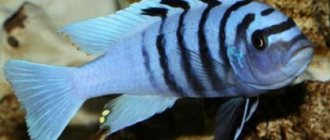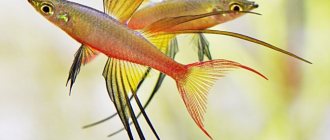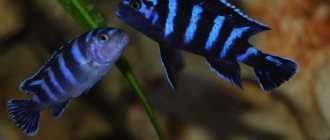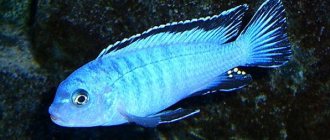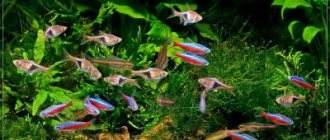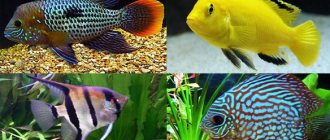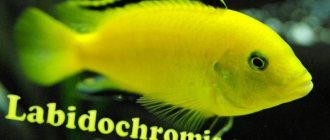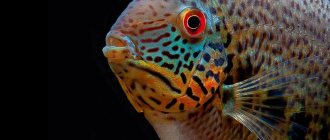Cichlids
Simplicity of content:
Latin name: Pseudotropheus demasoni
Lifespan: up to 10 years
Maximum size: 8 cm.
Average cost: 250 rub.
Pseudotropheus demasoni is a species of aquarium fish. They belong to the cichlid family, which belongs to the order Perciformes. In nature, the habitat is a lake called Malawi, located in Africa. This species' preference is for shallow waters with rocky areas, which is why their informal name is “rock dwellers.” Their incredible mobility and curiosity are combined with external attractiveness.
General information
The ray-finned fish pseudotropheus demasoni (lat. pseudotropheus demasoni) belongs to the family of dwarf aquarium cichlids. It was first described by Ed Konings, a cichlid expert, in 1994. After which it was included in the list of ornamental aquarium fish.
Demasoni are very active, curious inhabitants of the reservoir. In their natural environment they feed on algae, small vertebrates and insects.
A distinctive feature is the dark blue color of the body in combination with transverse stripes. In aquariums, the average lifespan is 10 years.
Description
The aquarium fish has an elongated body that resembles a torpedo. Its small size, ranging from 6 to 8 cm, allows Pseudotropheus demasoni to be classified as a “small” fish. Their entire body is covered with stripes of different colors. Vertical wide stripes have different colors: dark blue, almost black and light blue. The first dark stripe is located behind the gills, and the last one is near the beginning of the caudal fin. In total, there are six dark stripes and five light stripes on the body of Pseudotropheus demasoni.
Appearance of Pseudotropheus demasoni.
Narrower stripes decorate the head with their arrangement: two dark ones alternate with three blue ones. The first dark stripe is between the fish's eyes, and the other is on its forehead. It intersects with a vertical stripe on the body located behind the gills. The "chin" is blue. Thinner stripes of dark and blue colors, located horizontally, decorate the fin on the tail. The edge of the caudal fin is blue, emphasized by a dark blue line. Under stress, the color may become paler.
The peculiarity is the presence of only one hole in the nose. The function of smell is carried out by drawing water into a single nostril and holding it there for a while. This helps you recognize different smells. Despite their miniature size, pseudotropheus demasoni have an aggressive character. The presence of a rocky grotto, where the fish hide from excessive communication, can reduce aggression. Swimming into caves, they can spend a long time there. The varied style of their swimming is interesting - sideways, upside down, and even soaring. Pseudotropheus demasoni are vegetarians who eat mainly plant foods.
The aquarium for cichlids should have enough hiding places.
Keeping in an aquarium
Demasoni are demanding in terms of care and maintenance. Food, water quality and environment should be close to natural habitat conditions. An unfavorable environment can weaken the fish’s body and lead to death.
Aquarium dimensions
The container must hold at least 200 liters of water to support a group of cichlids of 5-7 individuals, one of which is male. Fish are prone to interspecific aggression in small tanks. The presence of more than 1 male also causes hostile behavior.
If you want to accommodate more than 7 inhabitants, a container with a volume of at least 400 liters is suitable. The number of individuals in one tank should not exceed 12. And also for each male there should be 3-4 females for comfortable coexistence.
Compatibility and Behavior
Pseudotropheus demasoni exhibit aggression towards other species of aquarium fish. Often they can only get along in a large tank with other cichlids, for example, Labidochromis yellow. For Demasoni, personal territory is important. Even the smallest male is capable of showing aggression and competition with a larger representative of another species. Pseudotropheus cannot tolerate individuals with a similar blue color or any stripes, for example, black-striped cichlids.
Labidochromis yellow
Keeping more than 1 male helps reduce aggressive behavior. There should be 3-4 females for each of them. Large groups eliminate the hostility of the dominant male against all others. Members of small groups will be systematically killed by the dominant male until he is left alone.
Only large friendly species are suitable as neighbors:
- catfish – ancistrus, synodontis;
- Pterygoplichthus;
- Bariancitrus;
- zebratropheus;
- melanothenia australis.
Pterygoplichthus
Melanothenia australis
Ancistrus
Bariancitrus
Kinds
This fish is presented in pet stores in a wide variety, since in nature there are many of its subspecies. They differ in color, size, character, etc.
Pseudotropheus zebra
It has a bluish or blue color. Vertical stripes are scattered throughout the body. The dorsal fin has a dark blue edging. Sometimes there are completely different colors. For example, white, blue, yellow, red (females only). Average size – 12 cm.
Pseudotropheus Demasoni
Has a hostile character. They grow no more than 9 cm. However, one couple may need a capacity of about 200 liters for a comfortable life. The body is dark blue with blue stripes. The fins near the tail are yellowish, brown or sandy.
Lombardo
Found near the islands of Namalenje and Mbenj. Cichlids grow about 10cm in length. Males are yellow with dark stripes, females are blue, also with stripes. To successfully contain pseudotropheus Lombardo, you will need a “jar” of over two hundred liters. These fish are distinguished by their aggressive nature and tendency to live territorially. For one male you need at least two females.
Atsey
An interesting animal that attracts attention due to its color. Color may vary depending on habitat
However, the most common species are blue with yellow fins. The fish grow up to 11-16 cm. They keep in schools, have a relatively calm character, they can be combined with other cichlids of a similar size.
Pseudotropheus red
Found naturally near the borders of Mozambique. Grows up to 13 cm. Sexual differences are very striking. Males are light blue with vertical stripes, with spots visible near the anal fin. Females can be brown-beige or red-orange. Pseudotropheus red is an aggressive fish that can get into fights with its relatives. Therefore, at least two females are placed with one male.
Elongatus Mpanga
Lives in the northwestern part of Lake Malawi. It reaches no more than 10 cm in length. The body is dark blue with light blue stripes. The fins are edged in black. The tail is bright yellow. They are kept mainly in species aquariums, but it is possible to be in proximity with other inhabitants of Lake Malawi.
Pindani or Sokolova
Just like the red pseudotropheus, it lives off the coast of Mozambique. Standard length (10-11cm). The body is light blue, the fins are edged with blue. It is almost impossible to identify individuals by gender. Mature males develop spots near the anal fin. Contained in containers of 170 liters. It has a calm disposition, which is not typical for cichlids of the Mbuna group.
Saulosi
A miniature species, growing no more than 9 cm in length. Cichlids vary greatly in size. Males are bright yellow, the leaders of the flock are blue, with dark stripes. In nature it is considered an endangered species.
Maingano
This fish lives at a depth of 3 to 10 cm. It lives near the shore of Likoma Island. They grow only up to 10 cm. The main color is dark blue, with longitudinal blue stripes. They keep about 200 liters in aquariums. Males are stubborn and aggressive, so it is better to keep a flock with one male.
Yohani
This fish was discovered by scientists in the first half of the last century. Lives at a depth of no more than 5 meters. Can be found near Cape Ngombo and the Mazinje rocks. Standard length. Males are light blue with horizontal stripes. There are light spots near the anal fin. Females and young animals are golden-orange, the stripes are almost invisible. A peaceful species that gets along with other inhabitants of Lake Malawi of similar size. Males do not like competitors and individuals visually similar to them. The recommended aquarium volume is from 130 liters.
Feeding
The main diet of the pseudotropheus cichlid consists of 70% plant food, the remaining 30% is animal food. Salad leaves scalded with boiling water, sprigs of greenery, nettle and dandelion leaves, small pieces of cucumbers and zucchini are offered as food for cichlids. Animal protein is provided by daphnia and cyclops. Eating shrimp and bloodworms can lead to obesity. Pet stores also offer various nutritional mixtures for cichlids with spirulina.
The fish are fed several times a day in small portions to avoid contamination of the water with uneaten leftovers.
Note! Fasting days are held once a week. But it should be borne in mind that for cichlids, fasting causes more harm than overeating. The species will live no more than 7 days without food.
Habitats
Metriaclima estherae, also known as Esther Grant's zebra, was described by Konings in 1995 and lives in Lake Malawi (Africa). The researcher named the species after Esther Grant, the wife of ichthyologist Stuart Grant.
Editorial: Fishes of Africa: Malawian cichids and Tanganyika fish
Although a significant portion of the Metriaclima estherae population lives near Minos Reef, some individuals can be found in Meluluca (Mozambique, Africa). Like most other mbuna, the fish likes to live in rocky places where it can find its favorite algae, aufwux. Aufwux are long algae that grow on rocks. They may contain insect larvae, nymphs, crustaceans, snails, mites and other zooplankton.
It is worth noting that this cichlid is known in science under three different names. This is a problem that has not yet been resolved. When the species was first discovered, it was dubbed Pseudotropheus estherae and classified as part of the genus Pseudotropheus, which contained a subgroup of related fish called "Zebras".
Later it turned out that the fish are not so close, and in order to separate “Zebras” into a separate genus in 1984, it was decided to call them Mailandia. This name comes from the surname of the famous ichthyologist - Hans Mayland. But there were also problems with this name, as it did not meet some of the requirements provided for scientific names. Therefore, it was given the status of "nomen nudum", meaning that the name cannot be used as a scientific name. However, this issue is still under discussion.
In 1997, it was decided to rename the fish Metriaclima. As before, there were also problems with the name. In this case, the requirements for changing scientific names were not met. In particular, the designation is not submitted to official bodies for approval. Although Metriaclima is now the scientific name, all dissenters have the right to use the former name. Therefore, both late 20th century names, Metriaclima estherae and Maylandia estherae, are considered correct, and in some circles even Pseudotropheus estherae is used.
Reproduction and breeding
Representatives of the species breed in captivity only in large groups of 12 individuals.
Females spawn when they reach 2.5 cm in length. In this case, the number of offspring is small. During the spawning period, the dominant male changes color and shows maximum aggression; he can kill other males if the aquarium is small and there is not enough hiding space.
The male swims around the female, pressing her against the rocks in his territory. The female lays eggs, 5-15 eggs at a time, then collects them in her mouth. At this time, the boy protrudes his anal fin, which the girl mistakes for an egg and takes it into her mouth. The release of milk leads to fertilization. The eggs are incubated in the mouth for 7 days. The young hatch at a temperature of 27°C and swim freely without hiding for 2 weeks.
Sexual Dimorphism
The fish is difficult to determine the sex of - they have absolutely no sexual dimorphism: males and females cannot be visually distinguished from each other, since both males and females have the same coloring and pattern. However, mature males tend to be slightly larger. The male has egg-shaped spots on his anal fin, while females may have fewer. The best way to distinguish the sexes is by observing their behavior, as males are more territorial and aggressive than females.
Obviously, only by comparing the size of the “genital papillae” can one unambiguously determine gender, but this method is for a person with experience.
Diseases and prevention
Pseudotrophius does not have an inherent susceptibility to disease. Proper care keeps fish healthy, but even small changes in keeping conditions provoke the development of diseases.
| Pathogens | Causes of appearance, symptoms, harm caused | Treatment |
| Protozoa parasite (causes ichthyophthyriosis, or "semolina disease") | Single-celled animals always live in water. Any type of aquatic life is susceptible to infection. The main symptoms are friction against the surface of objects. Small whitish tubercles, similar to semolina, appear on the bodies of fish. Untimely treatment leads to the death of the population and active infection of the remaining inhabitants of the aquarium | At the first signs of damage, the following measures are taken: · gradual increase in temperature to 30-32°C; · adding salt at the rate of 2 g of substance per 1 liter of water; · gradual replacement of bottom water; · use of a solution of Malachite green in a ratio of 50 ml of the drug per 100 liters of water. The course of treatment is at least 7-10 days |
| Vibrio Pseudomonas or Aeromonas bacteria (causes fin rot) | Water pollution leads to bacterial growth and damage to fins. New residents can also become carriers of the disease. Distinctive features: · bloating of the abdomen; · presence of ulcers, stripes, red spots; · change in the color of the fins to a dull blue color; · decomposition of fins; · blurred eyes. Sick individuals are unable to move and then die | Treatment involves reducing the number of pathogenic pathogens. To do this, a third of the water volume is replaced and the optimal temperature is maintained for keeping Demasoni. The infection is suppressed with one of the following drugs: 1. Levomycetin: 1 tablet is dissolved in 20 liters of water, then once every 3 days, change a third of the container and add a fresh solution. 2. Streptocide: 1.5 g of powder is calculated per 10 liters, dissolved in a separate vessel and poured into the aquarium. 3. Bicilin-5: 250,000 units of the product are mixed with 10 liters of liquid in a separate container, sick individuals are placed there for 30 minutes; the procedure is carried out within 6 days. 4. Biseptol-480: prepare a solution at the rate of 1/8 tablet per 5 liters of water and pour it into a tank with fish; course of treatment – 7 days |
| Intestinal parasites Trichomonas and Bodomonas (cause hexamitosis, or cichlid hole disease) | Polluted water, sudden changes in food, stress, and overcrowding of the aquarium cause the activity of intestinal parasites. The fish's immunity can no longer resist pathogens. The disease begins with loss of appetite, ending with complete refusal of food. Undigested food remains come out along with clear thread-like secretions. The abdomen inflates, the dorsal part dries out. The last stage is the appearance of deep ulcers over all surfaces of the body. In advanced cases, parasites attack internal organs. Doom is coming | “Hole disease” can be successfully treated with medications such as metronidazole. The medicine does not affect the state of the aquatic environment and biofiltration. 250 mg of medication is diluted in 35 liters of water and poured into the aquarium once. The course of therapy is 7 days. Before using the drug, replace a quarter of the volume of water in the tank. In the following days it is enough to replace 15% |
| Viral, bacterial and fungal infections of various kinds (cause exophthalmos, or bulging eyes) | Exophthalmos occurs as a result of improper care and insufficient water replacement. More often than not, one eye becomes much larger than the other. This occurs due to the accumulation of fluid in or behind the eyeball. The disease is contagious | They start by replacing the water and cleaning the aquarium of sediment. The fish's diet should consist of mineral food rich in vitamins. If the damage is severe, magnesium sulfate is used for treatment: 2 teaspoons of the substance are diluted in 20 liters of clean water. Then the sick cichlid is placed in a separate container with the prepared solution until complete recovery. |
| Parasite Oodinium Pillularis (causes oodiniasis) | Pathogens are introduced into the aquatic environment through new residents, plants, and water from an infected vessel. The first symptom is that the body becomes dull and covered with a small golden rash due to cell death. The scales peel off, the fins stick together and break off. Clear mucus discharges from the mouth. The fish swims in a zigzag. The disease leads to the death of individuals | Treatment is based on isolating sick representatives for quarantine and using medications. The water is treated with malachite greens with copper sulfate or a solution of bicillin-5 |
| Female parasitic crustaceans of the genus Lernaea (cause lerneosis) | Infection occurs through contaminated liquid or aquatic inhabitants. The body of cichlids is covered with small ribbon formations 1 cm long. The crustaceans attach themselves to the muscles of the prey and feed on its blood. This can lead to weakening, intoxication of the body and death | The affected cichlid is caught and placed in a separate container. Using tweezers, carefully remove the crustaceans. The parasites must be separated completely, otherwise an abscess will form. After this, chlorophos, previously diluted in a small amount of warm liquid, is introduced into the aquarium water. The procedure is repeated for 3 days. Then change half the volume of the tank to clean water |
Prevention remains the best cure for disease. Following the recommendations will help you avoid many health problems in aquatic life:
- Replace a third of the water in the container weekly with clean, settled liquid.
- Clean the soil once a week.
- Regularly inspect the vegetation and remove all rotting shoots.
- Nutrition should be balanced and regular.
- Temperature and lighting should be adjusted to the needs of the cichlids.
- Quarantine new individuals for 2 weeks.
- When purchasing, transport fish in soft containers to avoid impacts and damage.
- Do not use items that emit toxic substances for decoration.
- Do not use the same aquarium equipment for vessels with infected and healthy individuals.
Grotto in the aquarium
Keeping a Demasoni cichlid takes a lot of time and effort. The algorithm for caring for individuals is not simple. Fish live in vessels with fresh, highly alkaline water. A tank with a volume of at least 200 liters for 7 individuals should have a layer of rocky soil and a small amount of vegetation if desired. Grottoes and large stones imitating rocky terrain are always used as decorations. A constant aeration system is also necessary. The presence of powerful backlight lamps is not necessary. Demasoni feeds on pieces of processed vegetables and specialized food. Despite the brightness of color and beauty, fish are very aggressive towards neighbors and related individuals. Therefore, in most cases it is appropriate to keep them separate.
Was this information useful to you? Share in the comments!
